#potamotrygonidae
Text



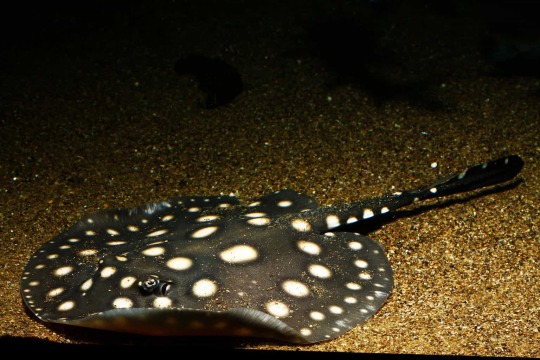

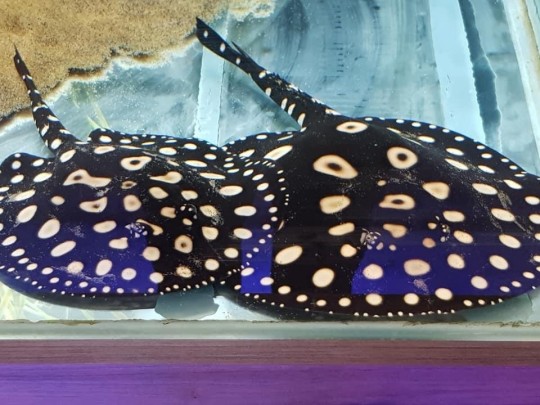


The Xingu River ray, also known as the black diamond stingray, white-blotched river stingray, or polka-dot stingray is a species of of freshwater stingray in the family Potamotrygonidae. It is endemic to the Xingu River basin in Brazil where it inhabits clearer waters with river rock and/ or sand bottoms. Xingu river rays primarily feed upon crustaceans, mollusks, small fish, worms, and other aquatic invertebrates. They are themselves preyed upon by otters, dolphins, crocodilians, large fishing birds, and large predator fish. Female xingu river rays are typically larger than males but both sexes are capable of reaching up to 13 inches (40cms) wide, 30 inches (60cms) long, and 45lbs (20kg) in weight. They sport a fairly short but wide tail and a flat circular body which is a deep black color along the back dotted with white or yellow colored spots. The underside is usually a dusky brown or tan. The Xingu river ray is a venomous stingray that contains venom localized at its dentine spine in its tail which is located just behind the dorsal fin. Used for self-defense, this stinger is tipped with barbs that can rip through flesh when withdrawn.The spines are constantly being shed and replaced, allowing the stingray to sometimes have two stingers as a new stinger grows in to replace the older one. Breeding occurs year round depending on water chemistry and food availability, after a 3 month gestation period the female gives birth to 2-6 pups. Under ideal conditions a xingu river ray may live upwards of 13 years.
#pleistocene#pleistocene pride#pliestocene pride#pliestocene#fish#shark week#ray#stingray#xingu#xingu river#xingu river ray#black diamond#black diamond stingray#polka dots#polka-dot stingray#spot#white-blotched stingray#south america#brazil
1 note
·
View note
Link
0 notes
Photo
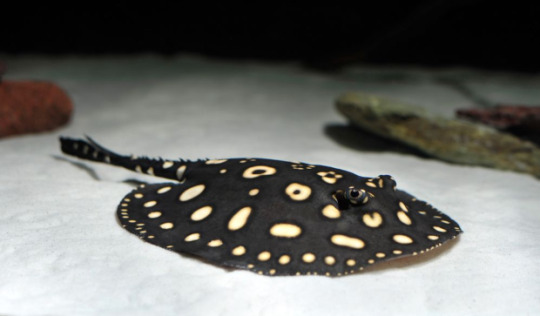
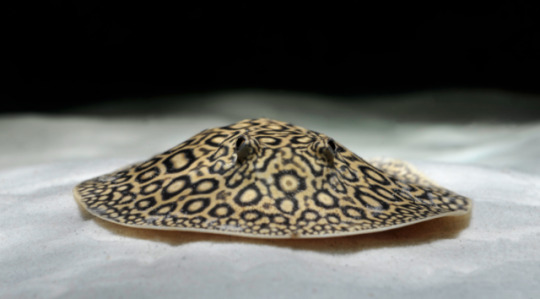
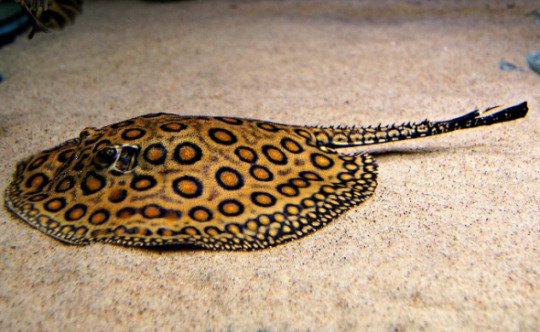
Freshwater Stingrays
Potamotrygonidae
#stingrays#freshwater stingrays#rays#potamotrygonidae#elasmobranchs#elasmobranchii#chondrichthyes#myliobatiformes#myliobatoidei#fish#ichthyology#cool#patterns#aquatic#aquatic life#animals#animalia#nature#biodiversity#wildlife#wildlife biology
3K notes
·
View notes
Photo
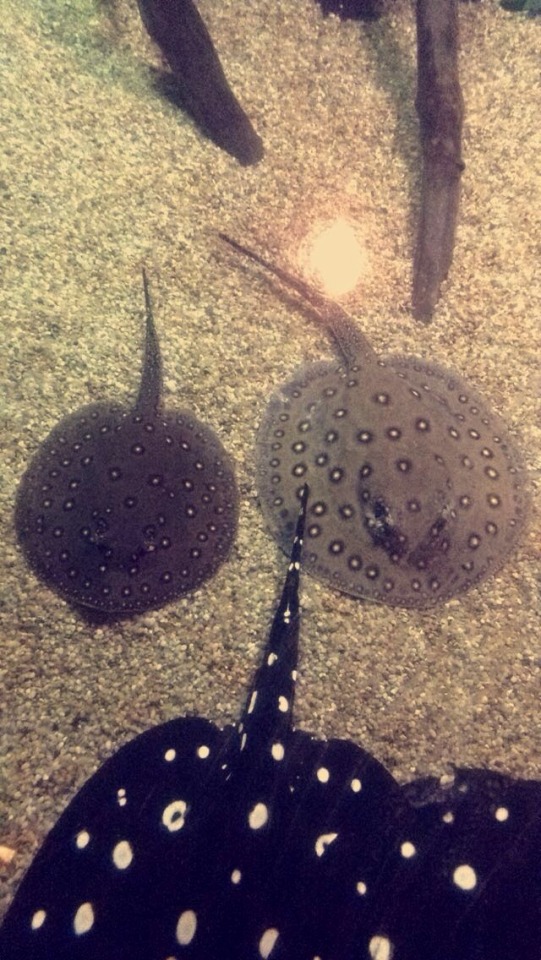
Look at these lovely river pancakes!!
27 notes
·
View notes
Photo

Colombian researchers at the National University of Colombia and the Colombian Foundation for the Research and Conservation of Sharks and Squalus (Squalus) were able to breed Magdalena river stingrays (Potamotrygon magdalenae) in captivity, after two effort year.
The Magdalena river stingray, as its names says, is estricted to the Magdalena and Atrato River basins in Northern Colombia, but it is locally abundant and among the predominant fish species in its range. Despite the rays is not vulnerable, the result of the work is the starting point of an opportunity to reduce the fishing pressure on the wild populations of this endemic species, and to propose conservation strategies, since the young are captured for ornamental purposes and due to the collapse of fisheries of other species, adults of the Magdalena Stingray are captured for subsistence.
Photo: Unimedios
Source: National University of Colombia (In spanish)
#Magdalena river stingray#Potamotrygon magdalenae#potamotrygon#rajids#elasmobranch#freshwater#chondrichthyes#rajiformes#Potamotrygonidae#science#conservation#freshwater conservation#biology#animals
17 notes
·
View notes
Photo
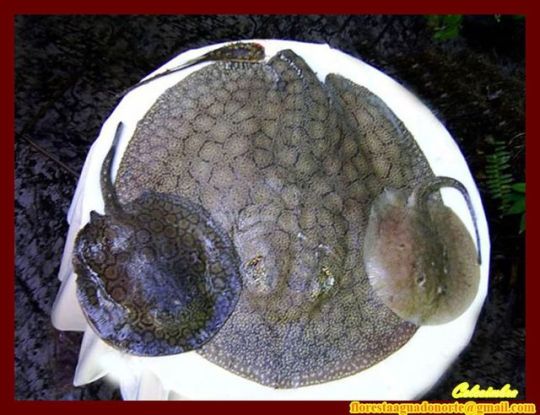
#Arraias #Paratrygon #Plesiotrygon #Potamotrygon #Potamotrygonidae #peixe #peixes #animal, #raia, #veneno, #fish, #celcoimbra, #florestaaguadonorte, #nomundodasmulheresdonorte, #amazonia, #amazônia, #amazon, #floresta, #agua, #água, #forest, #water, #brasil, #brazil, #brazilian, #natureza
#water#agua#arraias#paratrygon#floresta#água#veneno#forest#nomundodasmulheresdonorte#peixes#raia#amazonia#celcoimbra#brazil#amazon#potamotrygonidae#potamotrygon#natureza#animal#brazilian#amazônia#peixe#plesiotrygon#brasil#florestaaguadonorte#fish
0 notes
Photo

Xingu River ray
Potamotrygonida
Smithsonian's National Zoo
1 note
·
View note
Text
Marine Life: Stingrays
Kimgdom: Animalia
Phylum: Chordata (animals with a notochord for at least part of their life; a notochord is a flexible rod made out of a material similar to cartilage).
Subphylum: Vertebrata
Class: Chondrichthyes (cartilaginous fishes)
Subclass: Elasmobranchii (this subclass includes sharks, rays, skates and sawfish).
Superorder: Batoidea (rays)
Order: Myliobatiformes (one of four orders of batoids).
Suborder: Myliobatoidei (one of three suborders).
There are eight families of stingrays.
Most stingrays have a barbed stinger (or more than one) on their tail, modified from dermal denticles. It can be up to 35cm long, and is used in self-defence. The underside of the stinger has two grooves with venom glands. The actual venom is concentrated in the integumentary sheath – a thin layer of skin that covers the stinger. There are a few stingray species (e.g. the manta & porcupine rays) that don't have stingers.
Stingrays are commonly found in tropical & subtropical coastal waters, all around the world. Some are found in warmer temperate oceans, and others in the deep ocean.
The river stingrays (family Potamotyrgonidae) are only found in fresh water; so are some of the whiptail stingrays (family Dasyatidae).
Most stingrays live in the 2nd-lowest zone of the water column (they are demersal). However, some of them live in the pelagic zone (they are pelagic), such as the pelagic stingray, and the eagle rays (family Myliobatidae).
Behaviour
Because they're so flat, stingrays can hide very easily – they agitate the sand and then hide in it. Their eyes are on top of their bodies, and their mouths are on the underside. Therefore, as they actually can't see their prey, they use smell and their ampullae of Lorenzini (electoreceptors similar to what sharks have) instead.
When feeding, stingrays settle on the sea floor, with only their eyes & tails visible. Their favourite feeding grounds are coral reefs, and during high tide they share them with sharks.
Reproduction
For some stingray species (e.g. the round stingray or Urobatis halleri) use their ampullae of Lorenzini to sense certain electrical signals that mature females give off. When he courts a female, he follows her closely while biting at her pectoral disc. Then, he places one of his two claspers into the female's valve.
Female stingrays bear their young in litters of 5-13 – they are ovoviviparous, which means that the embryos develop in eggs, and stay in their mother's body until they're ready to hatch. The eggs stay in the stingray's womb, and there is no placenta. The embryos absorb nutrients from a yolk sac. After the yolk sac has been depleted, the mother provides uterine “milk”.
Female rays can store sperm for two years and not give birth until they decide the time is right.
Diet
Various stringrays have various ways of eating. Some have specialized jaws that they use to crush hard mollusc shells. Some have cephalic lobes (a type of external mouth structure) to guide plankton into the oral cavity.
Stingrays that reside on the sea floor (they are benthic) use a strategy called tenting. They wait until the prey comes close, then press their pectoral fins against the substrate and raise their head. This creates a suction force that pulls the prey under their body.
Stingrays have a wide variety of colours & patterns on their dorsal surface: this helps them to camouflages themselves in the sand. Some stingrays can change colour over the course of several days, in order to adjust to a new habitat.
For most stingrays, their main foods are molluscs, crustaceans, and occasionally small fish. In the Amazon, freshwater stingrays eat insects, breaking down the exoskeletons with mammal-like chewing motions. Some large pelagic rays (such as the manta ray) use ram feeding to eat huge amounts of plankton; some have been seen swimming in acrobatic patterns through plankton patches.
Stingrays and Humans
Stingrays can be caught with fishing lines or spears. Dried wings are the most common stingray dish around the world, but there are many different recipes. In Mayalsia & Singapore, the stingray is usually grilled over charcoal, then served with spicy sambal sauce.
The flaps (wings) are usually the most prized part of the stingray, as well as the cheek (area surrounding the eyes) and the liver. The rest is considered to be too rubbery to eat.
Stingrays are usually docile and curious, not aggressive. They will usually flee any disturbance, but sometimes they brush their fins past a new object they've encountered. However, some of the larger stingray species are more aggressive. Their stinger, which they use for defence, can cause injury or even death.
Divers and snorkellers can find stingrays in shallow, sandy waters, especially when the water is warm. (Swimmers usually can't see them.) There are sites where humans can swim with stingrays and even hand-feed them, such as in the Cayman Islands, Belize, many Tahitian island resorts, and the Caribbean island of Antigua.
Because stingray skin is hard and rough, it is often used for the under layer of the ito (cord/leather wrap) for Japanese swords. Some museums show arrowheads & spears made from stingers, used in places like Micronesia.
Stingray Families
Butterfly rays – Gymnuridae
Deepwater stingrays – Plesiobatidae
Eagle rays – Myliobatidae
River stingrays – Potamotrygonidae
Round rays – Urotrygonidae
Sixgill stingrays – Hexatrygonidae
Stingarees – Urolophidae
Whiptail stingrays – Dasyatidae
[Source]
22 notes
·
View notes
Photo

Ocellate river stingray (Potamotrygon motoro)
The ocellate river stingray is a species of freshwater stingray in the family Potamotrygonidae. It was the first species to be described in the family and is also the most widespread, ranging throughout much of the Río de la Plata, Amazon, Mearim and Orinoco basins in tropical and subtropical South America.
photo credits: Steven G. Johnson
#ocellate river stingray#Potamotrygon motoro#stingray#zoology#biology#biodiversity#science#wildlife#animals#cool critters
613 notes
·
View notes
Photo

(Photo/Info)
The short-tailed river stingray (Potamotrygon brachyura) is a species of river stingray (family Potamotrygonidae) native to the Río de la Plata Basin in South America, including the Paraguay, Paraná and Uruguay Rivers in the countries of Argentina, Brazil, Paraguay and Uruguay. It is sometimes known as the giant freshwater stingray, but this name is typically used for the southeast Asian Himantura polylepis.
Growing to a disc diameter of about 1.5 m (5 ft) and a weight of 220 kg (490 lb), the short-tailed river stingray is the largest freshwater species in its family. Female stingrays give birth to up to 19 fully formed young stingrays at one time. The pups start off eating plankton and then move on to consume small mollusks, crustaceans, the larvae of aquatic insects, and fish. They are hunted as food and for aquaria.
See more giant stingrays here.
#potamotrygon brachyura#giant stingray#short-tailed river stingray#river stingray#freshwater stingray#giant freshwater stingray#stingray#stingrays#ray#rays#marine life#wildlife#nature#marine science#marine biology
127 notes
·
View notes
Video
"Flap Flap Convention" - 🔵Maestro's Notes: Still on #SharkAwarenessDay2020 , This incredible Whiptail Ray aggregation was filmed on location in the Maldives courtesy of PADI IDC Staff Instructor, Underwater Wildlife Photographer and Filmmaker, My Good Friend, Mohamed Ahmed @sideytheshark Rays for days 😍 • The whiptail stingrays are a family, the Dasyatidae, of rays in the order Myliobatiformes. They are found worldwide in tropical to temperate marine waters, and a number of species have also penetrated into fresh water in Africa, Asia, and Australia. Members of this family have flattened pectoral fin discs that range from oval to diamond-like in shape. Their common name comes from their whip-like tails, which are much longer than the disc and lack dorsal and caudal fins. All whiptail stingrays, except the porcupine ray (Urogymnus asperrimus), have one or more venomous stings near the base of the tail, which is used in defense. They range in size from 0.18 to 2.0 m (0.59 to 6.56 ft) or more across. The taxonomy of Dasyatidae was revised by Peter Last, Gavin Naylor, and Mabel Manjaji-Matsumoto in 2016, based on morphological and molecular phylogenetic data. The placement of Megatrygon within the family is provisional pending further research, as evidence suggests it may be more closely related to the families Potamotrygonidae and Urotrygonidae than to other dasyatids. (at Maldives India Ocean) https://www.instagram.com/p/CC1jAFyBH1m/?igshid=1odrfqg4tx8pr
0 notes
Photo
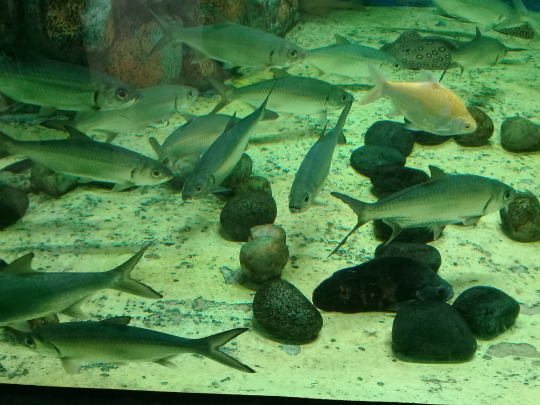
Red-Tailed Tinfoil Barb (Barbonymus altus), Ocellate River Stingray (Potamotrygon motoro), Indo-Pacific Tarpon (Megalops cyprinoides), Clown Knifefish (Chitala ornata)
The Red-Tailed Tinfoil Barb is a good-sized cyprinid fish that reaches up to about 8 inches (20 cm) in length. It has a large, distinct silvery metallic scales, red-tipped fins, and a forked tail characteristic of a fast-swimming fish.
The Ocellate River Stingray, also known as the Peacock-Eye Stingray, is a freshwater stingray in the family Potamotrygonidae. Ocellate River Stingrays have an oval disc-shaped body. The upper surface is grayish-brown with yellow-orange spots trimmed in black and the underside is white. Their eyes, positioned on the dorsal surface of their head, give them nearly 360 degrees field of vision. Their sense of smell is well-developed and around their mouth they have electrical sensors called Ampullae of Lorenzini that sense the natural electrical charges of potential prey and predators.
The Indo-Pacific Tarpon is also known as the Oxeye or Herring. Based on fossic research, Tarpon have been swimming in our oceans since prehistoric time. They are primarily found in shallow coastal waters and estuaries. Due to its majestic appearance of size and color, the Tarpon is nicknamed "Silver King".
The Clown Knifefish is a freshwater fish indigenous to tropical regions of Asia in river basins and lakes of Indochina, Thailand, Laos, Vietnam, Mekong, Chao Phraya, and Cambodia. They have a long, narrow body that reaches about 40 inches in length in adulthood. It is silver in color, and has several circular markings on its mid-body that become more defined as it matures.
0 notes
Text
Kỹ thuật nuôi cá đuối nước ngọt khỏe đẹp mà độc, lạ
Kỹ thuật nuôi cá đuối nước ngọt khỏe đẹp mà độc, lạ
Cá đuối nước ngọt là loài cá được xếp vào nhóm những loài cá cảnh đắt đỏ như đẹp hàng đầu ở Việt Nam thế nên việc nuôi cá này cần hết sức cẩn trọng.
Video màn uốn lượn đẹp mắt của cá đuối nước ngọt. Nguồn từ Ken Nhi Youtube
Cá đuối nước ngọt hay còn gọi cá sam – một chi cá đuối nước ngọt trong họ Potamotrygonidae thuộc bộ cá đuối. Chúng được ưa chuộng để nuôi làm cảnh với giá cả rất đắt.
Cá…
View On WordPress
0 notes
Photo
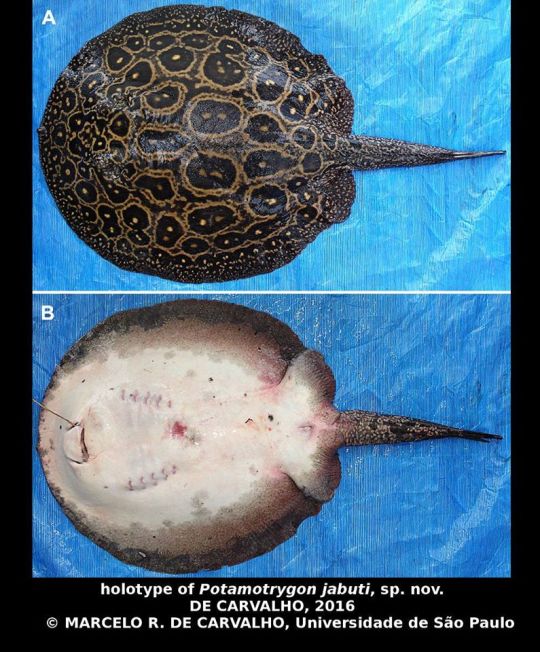
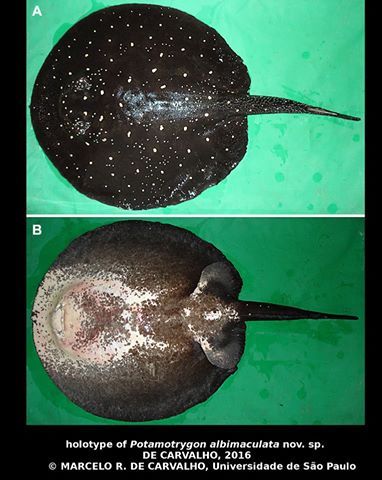
AMAZONIAN RIVER STINGRAY MORE DIVERSE THAN WE THOUGHT
Potamotrygon is a genus of freshwater stingrays native to the rivers of South America (with exception of Chile). Like other stingrays, Potamotrygon freshwater rays have venomous barbs at the base of their tails, and are dangerous species to humans. It is said that the natives of South America fear the stingray more than they do the piranha. These freshwater stingrays are sometimes kept as exotic aquarium fish. Two species endemic to the mid and upper Tapajós basin, discovered long ago and common in the ornamental fish trade were recently spotted in 2016 as new species.
The Tapajós river stingray (Potamotrygon albimaculata) is part of the black stingray species group, described by its blackish brown dorsal disc color with numerous and generally evenly-spaced small whitish spots and faint ocelli.
Pups look like this:
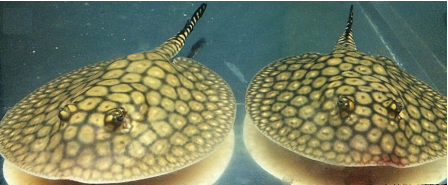
but then they growp up to this:

In Portuguese, this species frequently goes by the name "pretinha do Tapajós"; in English, the adopted common name is Tapajós freshwater stingray. In the aquarium trade this species is most frequently called "P14" or Itaituba ray.
And Pearl river stingray (Potamotrygon jabuti) described by its marbled color pattern that undergoes remarkable change with growth.

- Transition in color pattern from neonate to large adult passing through intermediate stages.
In Portuguese this species is widely known as "jabuti", in reference to its similarity in dorsal color to the common land-dwelling tortoises, especially when the disc is arched.
Both species co-occur in the relatively fast-flowing mid and upper Tapajós basin, but mostly occupy different areas of the river. Additionally, three new species may be present in the Tapajós basin, which has one of the most diverse stingray assemblages known together with the rios Negro and Tocantins-Araguaia. The ecological dynamics of stingray species in the mid and upper rio Tapajós are being further impacted by hydroelectric power stations in construction or in planning that will interrupt its fast-flowing rivers and result in more stagnant waters.
Reference: Carvalho 2016. Description of two extraordinary new species of freshwater stingrays of the genus Potamotrygon endemic to the rio Tapajós basin, Brazil (Chondrichthyes: Potamotrygonidae), with notes on other Tapajós stingrays. Zootaxa
#chondrichthyes#elasmobranch#Potamotrygonidae#potamotrygon#Potamotrygon albimaculata#Potamotrygon jabuti#Itaituba river stingray#Tapajós river stingray#Pearl river stingray#pretinha do Tapajós#science#sciblr#scienceblr#new species#south america#amazon#stingray#love them
510 notes
·
View notes
Photo
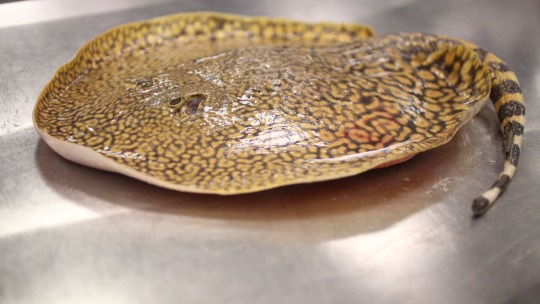


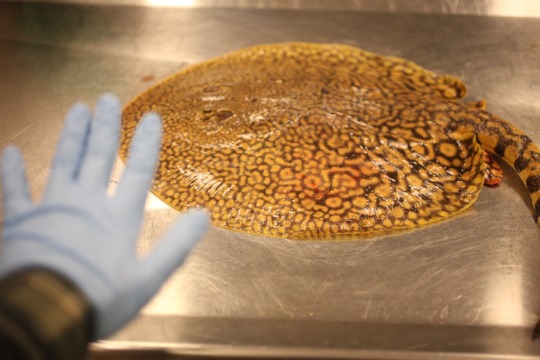
Unexpected Tiger Stingray from Peru came in to our collections at the end of the day on Friday. This thing must’ve easily been 2 ft tip to tip.
#things on my desk#stingray#tiger stingray#Potamotrygonidae#cartilaginous fish#fish#The Field Museum#Field Museum#FMNH
35 notes
·
View notes